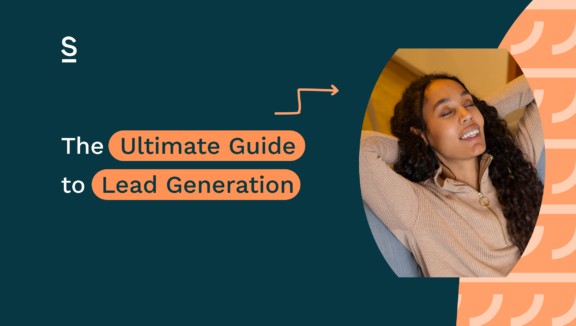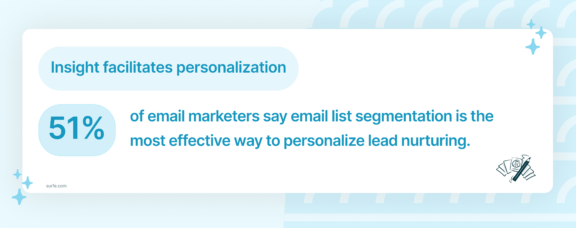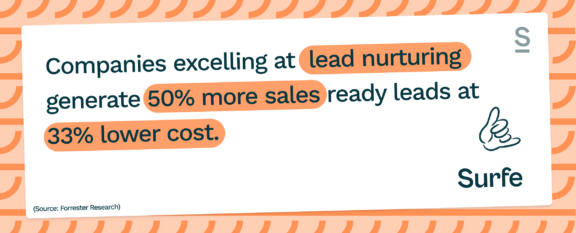The Ultimate Guide to Lead Generation

Mastering lead generation is crucial for SDRs and BDRs.
This article will guide you through identifying and nurturing high-quality leads on LinkedIn, blending strategies like creating your ICP, understanding customer intent, and developing a robust content strategy.
Dive in and discover how to transform cold contacts into engaged prospects and drive meaningful conversations, setting the stage for you to close more deals and build lasting customer relationships.
Key highlights:
The most important thing in lead generation is to know your customer
Lead generation starts with knowing who you’re looking for. You can do this by creating your Ideal Customer Profile (ICP).
Think of your ICP as a detailed picture of your perfect customer. This isn’t just about basic details like age or job title. It dives deeper into the specifics: what are their goals? What challenges are they facing? How do they make purchasing decisions? Understanding these aspects helps you tailor your pitch so that your messaging speaks directly to those who are most likely to be interested in what you have to offer.
Customer Intent in Sales
It’s crucial to have a data strategy around customer intent. Data gives you insight into who is starting to look for solutions like yours, even before they reach out to you directly.
Using intent data effectively means bringing your sales and marketing teams into alignment. It’s about focusing your efforts on the accounts that are showing real signs of interest and being ready to engage with them at the right time.
Identifying customer intent helps you not only in finding new potential customers, but also in keeping an eye on your existing ones to prevent them from slipping away.
By understanding their needs, intentions, and where they are in their journey, you can tailor your messages based on the specific interests and behaviors of your targets, whether they’re brand new, or long-term clients.
Apply Intent Data Early
But be sure to leverage buyer intent early on. The decision-making process is rarely a solo journey. There are many people involved, each with their unique perspectives and information needs and you can learn more about this in our article on ‘What is a buying group and why is it important in sales?’.
When you understand who these people are, and what they’re concerned with, you can craft messages that resonate on all levels. From the IT specialist concerned about integration issues, to the budget-conscious manager looking for cost-effective solutions, addressing the varied concerns of the buying committee increases your chances of influencing the purchase decision in your favor.

Educate Your Customers
When trying to convert potential leads into loyal customers, education is your most powerful tool. The role of using content for education is twofold: it engages your audience by answering their questions and solving their problems, and it establishes your company as a credible, trustworthy source of information.
Think of your content not just as marketing material, but as a means to educate, inform, and guide your potential customers through their decision-making process, bringing them to the right decision for them.
Your potential customers are on the lookout for information that can help them make informed decisions. They want to know not just what your product does, but how it can solve their specific problems, improve their operations, and drive their success. This is where the value of your content comes into play. By providing insights, best practices, case studies, and how-to guides, you can help explain complex topics and showcase the tangible benefits of your solutions.
How to Create an Educational Content Strategy for Lead Generation
Crafting a content strategy that effectively nurtures leads through their buying journey is like telling a compelling story that evolves with your audience. The journey typically unfolds across four key stages: Discover, Learn, Try, and Buy.
Each stage represents a different phase in the buyer’s journey, from initial awareness to the final decision to purchase. Tailoring your content to each of these stages ensures that your audience receives the right information at the right time, moving them smoothly along the path to becoming customers.
Discovery Stage
This is where potential customers first encounter your brand. They might not have a specific need in mind yet, so the goal is to grab their attention and spark interest. Content at this stage should be broad and engaging, top of the funnel stuff, designed to introduce your brand and its values. Think of captivating blog posts (you’re captivated by this, right?), insightful infographics, and introductory videos that highlight common problems and innovative trends in the industry.
Learning Stage
Now that you’ve caught their attention, potential customers are interested in learning more about how you can solve their problems. This is the educational phase, where more detailed and informative content comes into play. White papers, eBooks, and in-depth guides that provide valuable insights and showcase your expertise are perfect for this stage. The content should be designed to build trust and establish your brand as a thought leader in the space – but here we are definitely talking about more middle of the funnel heading toward bottom of the funnel content.
Trying Stage
By this point, potential customers are seriously considering your solutions but need reassurance that you’re the right choice. This is where you offer a closer look at your products or services and demonstrate their value. Content types like case studies, product demos, free trials, and detailed how-to guides allow potential customers to see the benefits of choosing your solution, addressing any reservations they might have.
Buying Stage
This is the final decision-making stage. At this point, potential customers are ready to make a purchase but might need a final nudge to go with you.
Content here should reinforce the decision to choose your product or service and make the purchasing process as smooth as possible. Competitive analyses, customer testimonials, security reassurances, and detailed spec sheets that affirm the superiority of your offerings can be effective.
The Importance of Sourcing Accurate Contact Data of Your Prospects
Without having accurate contact data of your prospects, you… can’t contact them. The foundation of any successful sales or marketing strategy lies in the ability to reach out personally to potential customers, so we’re going to need those contact details and they’re going to need to be accurate.
Surfe streamlines the LinkedIn prospecting process by providing users with a seamless way to capture and enrich contact details directly within LinkedIn.
You can add a promising prospect to your CRM with just a single click, or export lists from LinkedIn’s Sales Navigator, complete with verified emails and phone numbers. Surfe’s email finder for LinkedIn has up to 93% find rate – it’s better than anything else on the market.
It’s a Chrome extension designed with productivity in mind, offering integrations for HubSpot, Salesforce, Pipedrive, Copper, and even Google Sheets.
This means that the data you gather and enrich through Surfe can seamlessly flow into your existing sales processes, ensuring no prospect falls through the cracks.
Companies like Bolt, Google, and Amazon have noted significant improvements in leads, conversions, and the accuracy of contact data by incorporating Surfe into their sales strategies.

Find the email addresses of your prospects on LinkedIn
Source verified professional email addresses and mobile numbers with unmatched find rates and global coverage.
Lead Follow-Up and Nurture
After engaging your audience with tailored content, the next step is lead follow-up and nurture. This process is where the initial interest is transformed into concrete action.
Decision-makers often consume content with purpose, seeking solutions or insights to inform their decisions. Once they download a piece of content, the clock starts ticking.
On average, stakeholders are taking longer to make decisions, and reading more content while they do. This window is crucial for follow-up: it’s when their interest is highest and they’re most receptive to further engagement.
Expectations for follow-up are quite specific, some decision makers may expect a follow-up within just 16 hours after expressing interest. Meeting these expectations can set you apart from competitors, demonstrating your commitment to addressing their needs promptly. Check with your ICP to see how long you should wait before following up.
Tactics for Nurturing Leads Through Email:
Lead nurturing requires a strategy that continuously engages and moves the lead through the sales funnel, towards a decision.
Email stands out as a powerful tactic for this. It allows for personalized, targeted communication that can address the specific interests and needs of each lead.
Here’s how to make the most of it:
Personalized Emails
Customize your emails based on the content the lead has shown interest in. This shows that you’re paying attention to their needs and offering relevant solutions.
Read more about how to get a higher email response in sales here.
Educational Content
We already discussed this, but instead of pushing for a sale right away, focus on providing value. Share insights, tips, and resources that help them solve their problems. This builds trust and positions your brand as a helpful advisor, not just a vendor.
Progressive Qualification
Use each interaction as an opportunity to learn more about your lead. Ask questions or include interactive elements in your emails that encourage them to share more about their challenges and needs. This information can refine your nurturing strategy, making your communication even more targeted and effective as you qualify your leads more
Consistent Follow-Ups
Establish a schedule for your nurture emails that keeps your brand top of mind without overwhelming your leads. Consistency is key to keeping the conversation going and gradually moving leads down the funnel.
Multi-Touch, Multi-Channel Engagement
While email is a useful tool, integrating other channels like social media, webinars, and direct outreach will enhance your nurturing efforts. Each touchpoint should offer value and contribute to a cohesive narrative that guides the lead towards a decision.
Red Flags in Lead Generation
Unfortunately, lead generation doesn’t always go exactly to plan. Stay vigilant for signs that a partnership might not be heading in the right direction. Recognizing these red flags early can save you time, resources, and ensure your lead generation efforts stay on target:
Inconsistency in Lead Quality
High-quality, qualified leads are the lifeblood of your sales pipeline. They should be engaged, interested, and fit your ideal customer profile.
If you notice a significant number of leads failing to meet these criteria, or if there’s a noticeable drop in quality over time, it’s a clear sign to reassess your lead generation strategy.
Low Engagement Rates
Engagement is a key indicator of lead interest and potential for conversion. If your leads consistently show low engagement with your follow-up efforts, whether opening emails, responding to calls, or interacting with content, it’s time to question the quality of these leads, and maybe go back to the drawing board.
Questionable ROI
The ultimate measure of a lead generation campaign’s success is its return on investment (ROI). If your analysis reveals that the cost of acquiring leads outweighs the revenue they generate, or if the conversion rate from lead to customer is unsustainably low, these are serious indicators that your current strategy needs to change.
A One-Size-Fits-All Approach
Effective lead generation is not a cookie-cutter process. It requires a deep understanding of your business, your audience, and your market. If you’re employing a one-size-fits-all approach, lacking adaptation to your customer’s specific needs and goals, this lack of personalization can seriously harm your business.

Let’s wrap it up!
The key takeaway from this blog should be that sustainable business success hinges on your ability to, not just reach, but truly engage your target audience. This engagement is built on a foundation of personalized, insightful content that educates and informs at every stage of the buyer’s journey.
By tailoring your strategies to address the specific challenges and aspirations of your leads, you cultivate a relationship that positions your brand as a trusted advisor in their industry.
The importance of nurturing these relationships is an active process – your strategies should evolve as you gain deeper insights into your audience’s behavior and preferences. This should help you find, nurture, and ultimately convert more leads into long-term customers.
Learn more about how lead tracking can boost your sales, or read on for our answers to typical lead generation questions.

Save 3 hours per week generating leads with Surfe
Surfe allows you to automatically sync the details, contact information, and conversations you have on LinkedIn to your CRM in one click.
Lead Generation FAQs
What types of personalized content can be successful for lead generation?
Successful personalized content often addresses specific pain points or goals of the target audience. For example, a tech company might create an eBook tailored for the healthcare industry, discussing how their solution can help comply with patient data protection laws. Another example could be a series of case studies targeted at different roles within an organization, such as IT managers and C-suite executives, showcasing relevant success stories and outcomes. Good content should address a problem, and answer a question. All you have to do is match the problem to the right person, and you’re halfway there.
What challenges might I face when implementing new lead generation strategies and how can I overcome them?
Common challenges include aligning sales and marketing teams, ensuring data quality for targeting, and creating sufficiently personalized content for potential clients.
Overcoming these challenges often requires clear communication of goals and responsibilities, investing in reliable data sources, and developing a scalable content strategy that leverages customer insights for personalization.
How can small or medium-sized businesses implement lead generation strategies with limited resources?
SMBs can focus on a narrower set of high-value target accounts and use cost-effective tools for intent data and personalization. Tools like Surfe can allow you to scale your prospecting and lead generation immediately. Surfe removes the pain of manually adding contacts to your CRM or Google Sheet and finds their contact information for you along the way.
What role does customer feedback play in refining lead generation strategies?
Customer feedback is invaluable for understanding the effectiveness of your messaging, content, and overall approach to lead generation. It can highlight areas for improvement, reveal new customer needs, and guide content development. Incorporating regular feedback mechanisms, such as surveys or direct conversations into your strategy ensures that your efforts remain customer-centric.
What future trends in lead generation should businesses be aware of?
Emerging trends include the increasing use of AI in sales and machine learning for predicting customer behavior, the growing importance of privacy and data protection in personalization strategies, and the expansion of digital channels for engaging B2B buyers. Staying ahead of these trends requires ongoing learning, experimentation, and adaptability in your strategies.


